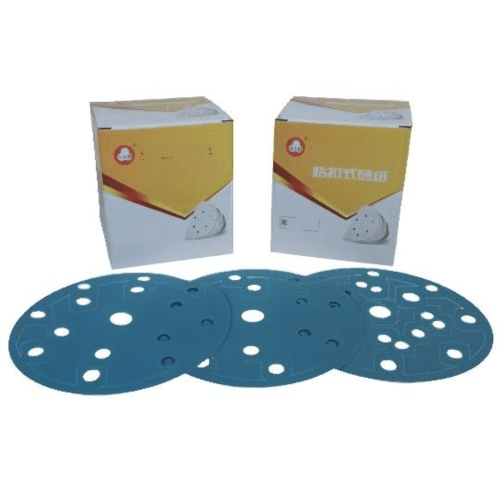Essential Guide to Selecting Perfect Cutting Discs for Professional Results
Selecting the right cutting disc for your project can mean the difference between a clean, efficient cut and a potentially dangerous failed attempt. Whether you're a professional contractor or a dedicated DIY enthusiast, understanding how to choose the appropriate cutting disc is crucial for both safety and optimal performance. The wide variety of cutting discs available on the market today serves different materials and applications, making it essential to know exactly what you need before making a purchase.
A cutting disc is more than just a consumable tool - it's a precision instrument designed to deliver specific results under particular conditions. From metal fabrication to masonry work, the right disc ensures not only the quality of your cuts but also maximizes the lifespan of your power tools and maintains workplace safety standards.
Understanding Cutting Disc Materials and Compositions
Abrasive Cutting Disc Fundamentals
The composition of a cutting disc plays a vital role in its performance capabilities. Traditional abrasive cutting discs are made from aluminum oxide or silicon carbide grains bonded together with special resins. These materials determine the disc's cutting ability, durability, and suitable applications. Aluminum oxide discs excel in cutting ferrous metals, while silicon carbide variants are better suited for non-ferrous materials.
The grain size and density of these abrasive materials significantly impact the cutting disc's performance. Coarser grains result in faster, more aggressive cutting but may leave rougher edges. Finer grains provide smoother cuts but require more time to complete the task. Understanding these characteristics helps in selecting the most efficient disc for your specific needs.
Diamond Cutting Disc Technology
Diamond cutting discs represent the premium segment of cutting tools, featuring industrial-grade diamonds embedded in a metal matrix. These discs are specifically designed for cutting hard materials like concrete, stone, and ceramic tiles. The diamond particles serve as multiple cutting edges that maintain their sharpness throughout the disc's lifetime.
The concentration and quality of diamonds used in the disc's construction directly influence its cutting performance and longevity. Higher diamond concentrations typically result in faster cutting speeds and longer disc life, though they come at a premium price point. The metal bond matrix holding the diamonds must be carefully engineered to wear at a rate that continuously exposes fresh diamond particles for optimal cutting efficiency.
Matching Disc Specifications to Applications
Size and Speed Requirements
The diameter of your cutting disc must match your power tool's specifications exactly. Using an incorrectly sized disc can lead to dangerous operating conditions and poor cutting results. The disc's maximum operating speed (typically marked in RPM) must never exceed your tool's capabilities. Additionally, consider the depth of cut required for your project - larger diameter discs provide deeper cutting capacity but may require more powerful tools to operate effectively.
Remember that thinner cutting discs generally provide faster cutting speeds and create less waste material, but may not last as long as thicker variants. For precision work, thin cutting discs are often preferred as they produce cleaner, more accurate cuts with less material loss.
Material-Specific Considerations
Different materials require specific cutting disc characteristics for optimal results. For instance, stainless steel requires cutting discs with special additives to prevent contamination and maintain the material's corrosion resistance. Concrete cutting discs need segment gaps for cooling and debris removal, while metal cutting discs typically feature continuous rims for smoother cuts.
The hardness of the material being cut should also influence your disc selection. Softer materials generally require discs with harder bonds to prevent premature wear, while harder materials need softer bonds that allow for controlled breakdown of the cutting surface, continuously exposing fresh abrasive particles.
Safety and Performance Features
Essential Safety Elements
Modern cutting discs incorporate various safety features that protect both the operator and the workpiece. Reinforced cores prevent disc rupture at high speeds, while specialized bonding agents ensure consistent performance throughout the disc's lifespan. Look for safety certifications and compliance with international standards such as EN 12413 for abrasive discs or EN 13236 for diamond discs.
Advanced cutting discs often feature direction arrows and usage instructions embossed directly on the disc surface. These markings help ensure proper installation and operation, reducing the risk of accidents. Additionally, many premium discs include color-coding systems that quickly identify their intended applications and materials.
Performance-Enhancing Design Features
Contemporary cutting disc designs incorporate innovative features that improve cutting efficiency and reduce operator fatigue. Ventilation slots help dissipate heat and remove cutting debris, while specially engineered gullets between segments enhance cooling and prevent binding. Some discs feature noise-reduction technology through laser-cut expansion slots or special damping compounds.
The latest cutting discs may also include wear indicators that show when replacement is necessary, preventing the use of worn tools that could compromise safety and performance. Advanced bonding technologies allow for thinner disc designs that reduce power requirements while maintaining structural integrity.
Maintenance and Usage Best Practices
Proper Storage and Handling
Cutting discs require careful handling and storage to maintain their integrity and performance. Store discs flat in a dry environment with stable temperature conditions. Avoid exposing them to moisture or extreme temperature variations, as these can compromise the bonding agents. Handle discs with care to prevent drops or impacts that could cause invisible damage to the disc structure.
When mounting a cutting disc, ensure all mounting surfaces are clean and free from debris. Use appropriate mounting hardware and tighten fasteners to the manufacturer's specified torque. Never force a disc onto the arbor or modify the mounting hole, as this can lead to dangerous operating conditions.
Optimizing Disc Life and Performance
To maximize the lifespan of your cutting disc, maintain consistent cutting pressure and avoid overheating. Allow the disc to do the cutting work without excessive force, which can cause glazing or premature wear. Regular inspection for signs of damage or wear ensures safe operation and optimal performance throughout the disc's service life.
When cutting, maintain the recommended cutting speed and feed rate for your specific disc type and material. Proper cooling, whether through built-in ventilation features or external cooling systems, significantly extends disc life and improves cut quality.
Frequently Asked Questions
How do I know when it's time to replace my cutting disc?
Replace your cutting disc when you notice any signs of wear such as reduced cutting efficiency, uneven wear patterns, or visible damage like chips or cracks. For diamond discs, replacement is necessary when the segments are worn close to the core. Additionally, if you hear unusual sounds during operation or experience increased vibration, these are clear indicators that disc replacement is needed.
Can I use the same cutting disc for different materials?
While some cutting discs are marketed as multi-purpose, it's best to use discs specifically designed for your target material. Using the wrong disc type can result in poor performance, accelerated wear, and potential safety hazards. Always check the manufacturer's specifications and material compatibility before using a disc on a new material type.
What safety equipment should I use with cutting discs?
Essential safety equipment includes safety glasses or a full face shield, hearing protection, dust mask or respirator, protective gloves, and appropriate work clothing. Ensure your work area is well-ventilated and free from flammable materials. Always use the proper guard on your power tool and follow all safety guidelines provided by both the tool and disc manufacturers.


